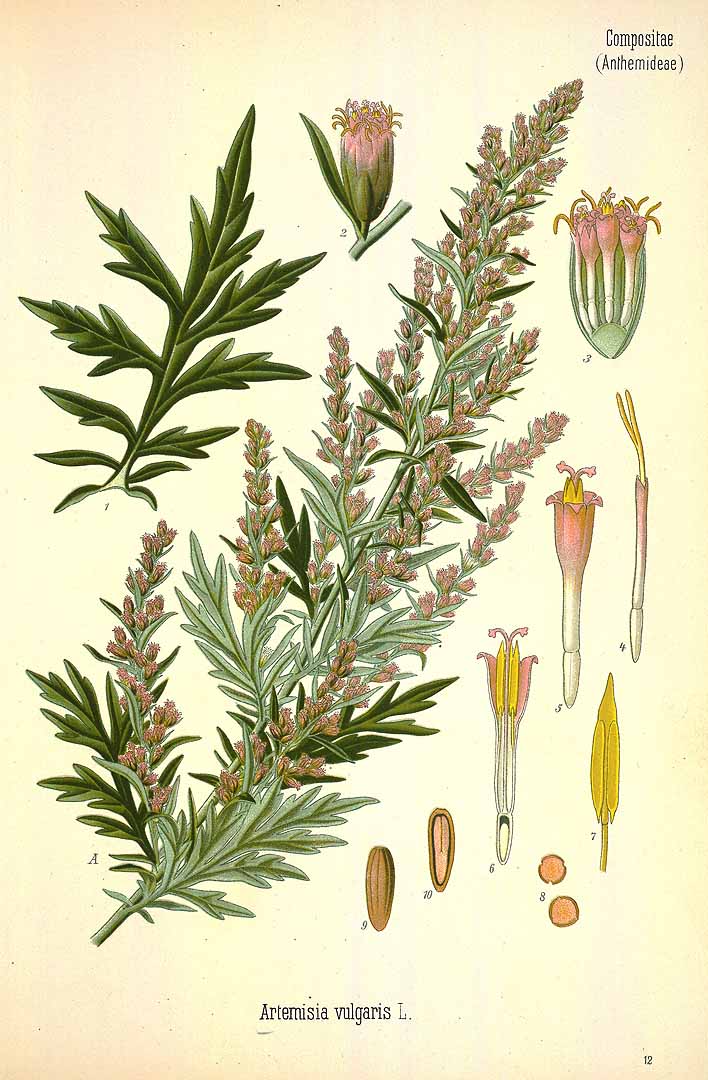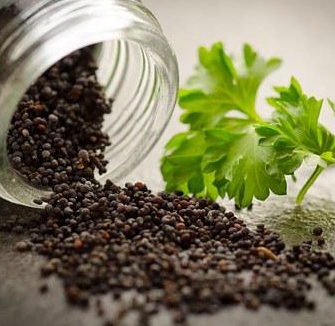A classic herb in both medicine and magic, mugwort has a long history of use in both herbal medicine as well as more esoteric practices.
Mugwort is the herb that becomes Moxa, a traditional preparation used in TCM in very similar ways to acupuncture. The prepared herb is placed on acupuncture points and burned to bring energy to the spot, sometimes directly on the skin, other times on top of a barrier or even on the tip of an acupuncture needle. It is also used in stick form to warm larger areas of the body.
Ancient lore references mugwort crowns being worn on Midsummer’s day to keep evil spirits from attacking. And in China Mugwort is hung on doorways to ward off evil.
Mugwort also has a long history of use as an herb of dreaming, helping to bring about lucid and pleasant dreams. It can be used both in tea and in dream pillows to achieve this effect, and pairs nicely with calendula and lavender to enhance these effects.
Mugwort, and all Artemesia species, can be used as a substitute for white sage in smudge bundles as they too have a clearing effect on both spaces and people; which is a nice option for those who don’t have white sage they can harvest locally or sustainably (White sage, Salvia, is an endangered plant and is illegal to harvest in many places.)
Medicinally, mugwort is most commonly used as an emmenagogue to help bring about menses, particularly in those who run on the cold side. It is also considered an abortifacient and should not be used during pregnancy.
It’s powerful anti-parasitic and anthelmintic properties make it perfect for cases of parasitic bacteria or worm infections in the gut. Not only will it assist in the killing of the pathogens, it is strongly astringent and drying and will help slow or stop diarrhea that often accompanies these types on infections. It’s warming carminative and bitter properties will also aid in the soothing of gas, bloating, and digestive discomfort that may also be present.
Overall, this plant has a strong calming and clearing energy when used internally, lending itself well to being a nervine when one needs to clear their head and calm their senses, but it should be used in small amounts for this purpose, and may be good to combine with other plants to avoid over-aggravating your digestive system.

MATERIA MEDICA: MUGWORT
Latin Name: Artemesia vulgaris
Plant Family: Asteraceae
Other Names
- TCM Name – Ài (or àicǎo)
- Ayurvedic Name – Nagadamani
Geographic Distribution: Europe, Asia, northern Africa, the United States
Botanical Description:
Mugwort is a tall perennial that can reach up to 3 feet in height with pinnate leaves that are downy and silvery-gray on the undersides. Tiny yellow or reddish flowers appear in late summer are distributed in clustered branches. The root light brown, woody, and about 8 inches long.
Harvesting Guidelines:
For internal use, harvest mugwort leaf at the end of summer before it flowers. Roots may be harvested in fall. For use as an incense or in a dream pillow, harvest during flowering/seeding.
Key Constituents:
Volatile oils, sesquiterpene lactones, tannins, flavonoids, coumarin derivatives, triterpenes (Hoffman, 2003).
Energetics:
- Warm
- Dry
Taste:
- Bitter
- Aromatic
Direction in the Body:
- Relaxing
- Outward
- Down
Herbal Actions:
- Digestive
- Emmenagogue
- Nervine
- Anti-parasitic
- Anthelmintic
- Abortifacient
- Carminative
- Cholagogue
- Diaphoretic
Body Parts Affected:
- Anywhere moxa is placed will be affected by mugwort
- Digestive tissues
- Female reproductive tract
Uses:
- It’s anti-parasitic and anthelmintic properties lend it well to cases of infection, particularly in the digestive system where it’s bitter and astringent properties will also aid in toning of the digestive tract tissues
- Good for cases of diarrhea
- Helpful for those with scanty or absent menses, particularly if they are a ‘cold’ person
- Moxibustion is a common practice in TCM and is often applied before acupuncture or sometimes in conjunction with acupuncture. Moxa is a special preparation of Mugwort that makes is easy to use for burning. It is fragrant, flammable, and when burning brings heat and warmth to an area. This heat and warmth are good for warming associated channels to dispel cold, strengthen Yang-Qi, remove stasis of the blood, and to dissipate stagnation.
- It can be seen as the Yin alternative to the Yang practice of acupuncture.
- Moxa is very commonly used postpartum to bring warmth back into the womb space
Dosing/Ways to Use:
- Tea: 1-2 teaspoons steeped in hot water for 15 minutes in a covered vessel.
- Tincture: 1-4 mL of a 1:5 in 25% 3x/day
- Moxa – direct or indirect application topically, also great as a moxa stick, particularly postpartum
- Dosage information from Medical Herbalism by David Hoffman.
Safety:
- Level 3 herb
- Toxic in large doses
- Do not use during pregnancy
BUY MUGWORT HERE
Resources:
- https://herbalmateriamedica2folio.wordpress.com/2015/04/15/mugwort-artemisia-vulgaris/
- Cardini F. & Weixin H. (1998). Moxibustion for correction of breech presentation: A randomized controlled trial. JAMA 280(18), 1580-1584.
- Chevallier, Andrew. (2000). Encyclopedia of Herbal Medicine. New York, NY: DK Publishing
- Coyle ME, Smith CA, & Peat B. (2012). Cephalic version by moxibustion for breech presentation. Cochrane Database of Systematic Reviews 2012, Issue 5. Art. No: CD003928.
- Gladstar, Rosemary. (1993). Herbal Healing for Women. New York, NY: Fireside Books
- Grieve, Maude. (1971). A Modern Herbal. (Original work published 1931). New York, NY: Dover Publications.
- Herbal Academy’s Herbarium Monograph
- Hoffman, David. (2003). Medical Herbalism. Rochester, VT: Healing Arts Press
- Khalsa, Karta Purkh Singh, and Tierra, Michael. (2008). The Way of Ayurvedic Herbs. Twin Lakes, WI: Lotus Press
- Moxibustion. (n.d.). Acupuncture Today. Retrieved September 2014 from http://www.acupuncturetoday.com/abc/moxibustion.php
- Mugwort Herb (Ai Ye). (n.d.). Chinese Herbs Healing. Retrieved September 2014 from http://www.chineseherbshealing.com/ai-ye-why-mugwort-leaf-stops-bleeding/
- Mugwort. (1988). Commission E Monographs. American Botanical Council.
- Vas J, Aranda-Regules JM, Modesto M, et al. (2013). Acupuncture Medicine 31: 31-38. http://www.ncbi.nlm.nih.gov/pubmed/23249535
- Wood, Matthew. (2004). The Practice of Traditional Western Herbalism. Berkeley, CA: North Atlantic Books

Don’t Miss a Thing!
Enter your email below to be the first to know about sales, new products and tips for taking care of your pieces.

